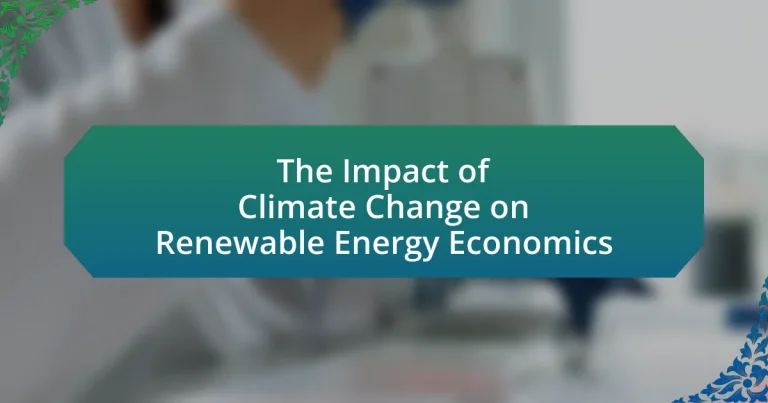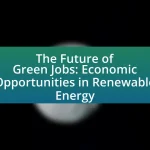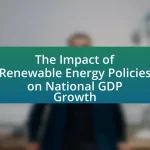The article examines the impact of climate change on renewable energy economics, highlighting how shifting energy demand patterns and investment decisions are influenced by climate-related factors. It discusses the economic benefits of transitioning to renewable energy, including potential savings of up to $160 trillion by 2050, and the challenges posed by extreme weather events that can increase production costs and disrupt infrastructure. Key topics include the role of government policies in promoting renewable energy, the economic implications of renewable energy adoption, and the emerging trends in energy consumption driven by climate awareness. The article also addresses the barriers to investment and strategies for enhancing the resilience and economic viability of renewable energy systems in a changing climate.
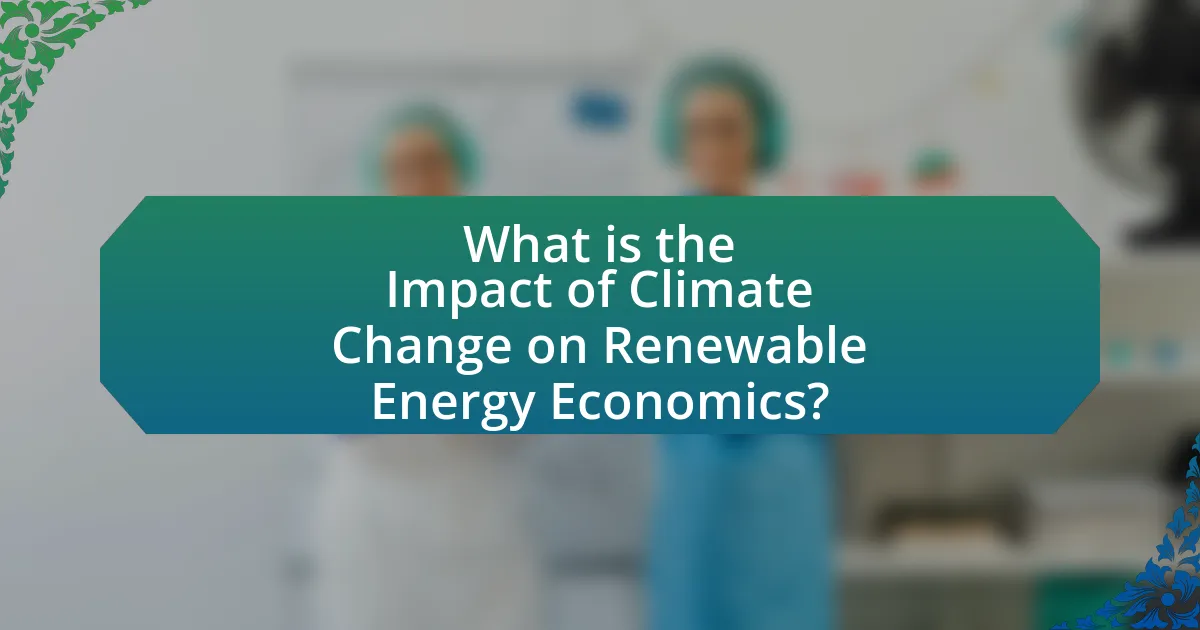
What is the Impact of Climate Change on Renewable Energy Economics?
Climate change significantly impacts renewable energy economics by altering energy demand patterns and influencing investment decisions. As climate change leads to more extreme weather events, energy systems face increased stress, prompting a shift towards more resilient and sustainable energy sources. For instance, the International Renewable Energy Agency (IRENA) reported that transitioning to renewable energy could save the global economy up to $160 trillion by 2050, highlighting the economic benefits of addressing climate change through renewable energy investments. Additionally, government policies aimed at reducing carbon emissions often incentivize renewable energy development, further enhancing its economic viability.
How does climate change influence the cost of renewable energy production?
Climate change influences the cost of renewable energy production primarily through its impact on resource availability and infrastructure resilience. For instance, increased frequency of extreme weather events can damage renewable energy infrastructure, leading to higher repair and maintenance costs. According to a report by the International Renewable Energy Agency (IRENA), climate-related disruptions can increase operational costs by up to 20% for wind and solar energy systems. Additionally, shifts in climate patterns can affect the efficiency of energy production; for example, reduced water availability can impact hydropower generation, thereby increasing reliance on alternative energy sources and potentially raising costs.
What factors contribute to changes in production costs due to climate change?
Changes in production costs due to climate change are primarily influenced by extreme weather events, resource availability, and regulatory changes. Extreme weather events, such as hurricanes and droughts, can disrupt supply chains and damage infrastructure, leading to increased costs for production. Resource availability is affected as climate change alters the distribution and quality of natural resources, such as water and raw materials, which can drive up costs. Additionally, regulatory changes aimed at mitigating climate impacts can impose new compliance costs on businesses, further affecting production expenses. For instance, the International Renewable Energy Agency reported that climate-related disruptions could increase energy production costs by up to 30% in vulnerable regions.
How do extreme weather events affect renewable energy infrastructure?
Extreme weather events significantly disrupt renewable energy infrastructure by causing physical damage and operational inefficiencies. For instance, hurricanes can destroy wind turbines and solar panels, while flooding can damage electrical systems and transmission lines. According to a report by the National Renewable Energy Laboratory, extreme weather events have led to increased maintenance costs and reduced energy output, with some regions experiencing up to a 30% decrease in renewable energy generation during severe weather conditions. This impact not only affects the immediate energy supply but also raises long-term economic concerns regarding the resilience and reliability of renewable energy systems in the face of climate change.
What are the economic implications of transitioning to renewable energy in a changing climate?
Transitioning to renewable energy in a changing climate has significant economic implications, including job creation, reduced energy costs, and increased investment in green technologies. The International Renewable Energy Agency reported that the renewable energy sector employed over 11 million people globally in 2018, with projections suggesting this number could rise to 24 million by 2030 as countries shift towards sustainable energy sources. Additionally, the levelized cost of electricity from renewables has decreased dramatically; for instance, the cost of solar power fell by 89% between 2009 and 2020, making it increasingly competitive with fossil fuels. This transition also attracts substantial investments; BloombergNEF estimated that global investment in renewable energy reached $501 billion in 2020, indicating a strong economic shift towards sustainable practices. Overall, the economic implications of this transition are profound, fostering growth, innovation, and resilience in the face of climate change.
How does climate change affect investment in renewable energy technologies?
Climate change significantly drives investment in renewable energy technologies by increasing the urgency for sustainable solutions. As global temperatures rise and extreme weather events become more frequent, governments and businesses recognize the need to transition from fossil fuels to cleaner energy sources. For instance, the International Renewable Energy Agency reported that global investment in renewable energy reached $303.5 billion in 2020, reflecting a growing commitment to combat climate change. Additionally, policies aimed at reducing carbon emissions, such as the Paris Agreement, incentivize investments in renewables, leading to a projected increase in capacity and technological advancements in the sector.
What role do government policies play in shaping renewable energy economics amid climate change?
Government policies play a crucial role in shaping renewable energy economics amid climate change by providing regulatory frameworks, financial incentives, and support for research and development. These policies, such as tax credits, subsidies, and renewable energy mandates, lower the cost of renewable technologies and encourage investment in clean energy sources. For instance, the U.S. federal Investment Tax Credit (ITC) has significantly boosted solar energy deployment, resulting in a 167% increase in solar capacity from 2016 to 2020. Additionally, government policies can drive innovation and efficiency improvements in renewable energy technologies, further enhancing their economic viability.

How does climate change affect the demand for renewable energy?
Climate change significantly increases the demand for renewable energy as nations seek to reduce greenhouse gas emissions and transition to sustainable energy sources. The urgency to mitigate climate impacts drives investments in solar, wind, and other renewable technologies. For instance, the International Energy Agency reported that global renewable energy capacity grew by 45% in 2020, largely due to climate policies and the need for cleaner energy solutions. This trend reflects a broader shift in energy markets, where countries are committing to net-zero emissions targets, further boosting the demand for renewable energy.
What trends are emerging in renewable energy consumption due to climate change?
Emerging trends in renewable energy consumption due to climate change include a significant increase in the adoption of solar and wind energy technologies. This shift is driven by the urgent need to reduce greenhouse gas emissions and mitigate climate impacts, as evidenced by the International Energy Agency reporting that global renewable energy capacity grew by 10.3% in 2020, despite the pandemic. Additionally, there is a growing trend towards decentralized energy systems, where consumers generate their own energy, reflecting a shift in energy consumption patterns influenced by climate awareness and policy incentives. Furthermore, investments in energy storage solutions are rising, as they are essential for managing the intermittent nature of renewable sources, with the global energy storage market projected to reach $546 billion by 2035. These trends highlight a transformative shift in energy consumption patterns as societies adapt to the realities of climate change.
How do public perceptions of climate change influence renewable energy adoption?
Public perceptions of climate change significantly influence renewable energy adoption by shaping consumer demand and policy support. When the public views climate change as a critical issue, they are more likely to advocate for and invest in renewable energy solutions, leading to increased market growth. For instance, a 2021 survey by the Pew Research Center found that 79% of Americans believe that climate change is a major threat, which correlates with higher support for renewable energy initiatives and policies aimed at reducing carbon emissions. This heightened awareness drives both individual choices, such as purchasing solar panels, and collective actions, such as supporting legislation that promotes clean energy technologies.
What sectors are driving the demand for renewable energy in response to climate change?
The sectors driving the demand for renewable energy in response to climate change include the transportation, electricity generation, and industrial sectors. The transportation sector is increasingly adopting electric vehicles and alternative fuels to reduce greenhouse gas emissions, with electric vehicle sales projected to reach 30% of total vehicle sales by 2030. The electricity generation sector is transitioning from fossil fuels to renewable sources like solar and wind, with renewables expected to account for 50% of global electricity generation by 2030. The industrial sector is also investing in renewable energy to meet sustainability goals and reduce carbon footprints, with many companies committing to 100% renewable energy usage by 2030. These trends reflect a broader shift towards sustainability driven by regulatory pressures, consumer demand, and corporate responsibility initiatives.
How do renewable energy sources compare economically in the context of climate change?
Renewable energy sources are generally more economically favorable in the context of climate change compared to fossil fuels. The International Renewable Energy Agency (IRENA) reported that the cost of solar photovoltaic (PV) and onshore wind energy has decreased by 82% and 49% respectively since 2010, making them the cheapest sources of new electricity generation in many regions. Additionally, transitioning to renewable energy can mitigate the economic impacts of climate change, which the National Oceanic and Atmospheric Administration (NOAA) estimates could cost the U.S. economy up to $1.9 trillion annually by 2100 if no action is taken. Thus, investing in renewable energy not only reduces greenhouse gas emissions but also offers significant long-term economic benefits by avoiding the costs associated with climate change.
What are the cost comparisons between solar, wind, and other renewable sources in a changing climate?
The cost comparisons between solar, wind, and other renewable sources indicate that solar energy has become the most cost-effective option, with prices dropping to around $30 per megawatt-hour in 2022, while onshore wind costs approximately $40 per megawatt-hour. In contrast, offshore wind is more expensive, averaging about $70 per megawatt-hour. Other renewable sources, such as biomass and geothermal, generally fall between these figures, with biomass costing around $60 per megawatt-hour and geothermal varying widely based on location but often exceeding $50 per megawatt-hour. These trends reflect the decreasing costs of technology and increased efficiency in renewable energy generation, which are crucial as climate change impacts energy demand and infrastructure resilience.
How do subsidies and incentives impact the economic viability of different renewable energy sources?
Subsidies and incentives significantly enhance the economic viability of various renewable energy sources by reducing initial capital costs and improving return on investment. For instance, the U.S. federal Investment Tax Credit (ITC) allows solar energy projects to deduct a substantial percentage of their installation costs from federal taxes, which has led to a dramatic increase in solar capacity, growing from 1.2 gigawatts in 2008 to over 100 gigawatts by 2020. Similarly, feed-in tariffs in countries like Germany have guaranteed fixed payments for renewable energy producers, fostering a stable market environment that encourages investment. These financial mechanisms lower the barriers to entry for renewable technologies, making them more competitive against fossil fuels and accelerating their adoption in the energy market.
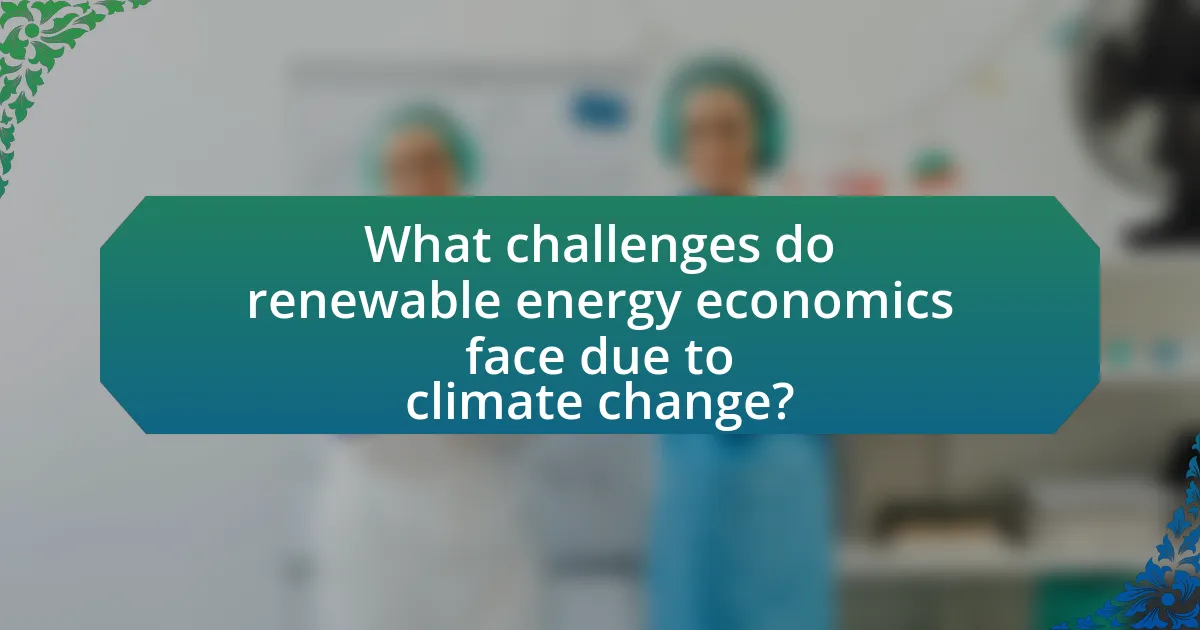
What challenges do renewable energy economics face due to climate change?
Renewable energy economics face significant challenges due to climate change, primarily through increased volatility in energy supply and demand. Climate change leads to extreme weather events, which can disrupt energy generation from sources like solar and wind, resulting in inconsistent energy availability. For instance, a study by the National Renewable Energy Laboratory found that climate-related disruptions could reduce wind energy output by up to 20% in certain regions. Additionally, changing weather patterns can alter energy consumption patterns, complicating demand forecasting and economic planning for renewable energy projects. These factors create financial uncertainty, making it difficult for investors to assess the viability of renewable energy investments.
What are the main barriers to renewable energy investment in the face of climate change?
The main barriers to renewable energy investment in the face of climate change include high initial capital costs, regulatory uncertainties, and inadequate infrastructure. High initial capital costs deter investors, as renewable energy projects often require significant upfront investment compared to fossil fuels. Regulatory uncertainties arise from inconsistent policies and incentives, which create a volatile investment environment. Inadequate infrastructure, such as limited grid capacity and lack of energy storage solutions, hampers the integration of renewable energy sources into existing systems. These barriers collectively hinder the transition to renewable energy despite the pressing need for climate action.
How do supply chain disruptions caused by climate change affect renewable energy projects?
Supply chain disruptions caused by climate change significantly hinder renewable energy projects by delaying the availability of critical materials and components. For instance, extreme weather events can damage infrastructure, such as roads and ports, which are essential for transporting solar panels and wind turbine parts. According to a report by the International Renewable Energy Agency, supply chain interruptions can lead to project delays of up to 12 months, increasing costs and reducing the overall feasibility of renewable energy investments. Additionally, climate-related resource scarcity, such as shortages of rare earth metals used in renewable technologies, further complicates procurement processes, ultimately impacting project timelines and budgets.
What financial risks are associated with renewable energy investments in a volatile climate?
Financial risks associated with renewable energy investments in a volatile climate include fluctuating energy prices, regulatory changes, and extreme weather events. Fluctuating energy prices can lead to unpredictable revenue streams, as seen in the solar and wind sectors where market prices can vary significantly based on demand and supply dynamics. Regulatory changes, such as shifts in government policies or incentives, can impact project viability; for instance, the reduction of subsidies in various countries has previously led to decreased investment in renewable projects. Extreme weather events, exacerbated by climate change, can damage infrastructure and disrupt energy production, as evidenced by hurricanes affecting wind farms and floods impacting solar installations. These factors collectively contribute to the financial uncertainty surrounding renewable energy investments in a changing climate.
How can renewable energy economics adapt to the challenges posed by climate change?
Renewable energy economics can adapt to the challenges posed by climate change by integrating climate risk assessments into financial models and investment strategies. This adaptation involves quantifying the potential impacts of climate change on energy production, infrastructure resilience, and market demand. For instance, the International Renewable Energy Agency (IRENA) reports that incorporating climate scenarios into energy planning can enhance the robustness of investments, leading to more sustainable economic outcomes. Additionally, policies that incentivize innovation in renewable technologies and promote energy efficiency can further align economic frameworks with climate resilience, as evidenced by the growth of green bonds, which reached over $1 trillion in issuance by 2021, demonstrating a shift towards financing that considers environmental impacts.
What strategies can investors use to mitigate risks related to climate change?
Investors can mitigate risks related to climate change by diversifying their portfolios, investing in sustainable assets, and engaging in active shareholder advocacy. Diversification reduces exposure to any single sector adversely affected by climate change, while sustainable assets, such as renewable energy projects, are increasingly seen as resilient investments due to the global shift towards low-carbon economies. Active shareholder advocacy allows investors to influence corporate practices and policies, pushing companies to adopt more sustainable practices, which can enhance long-term profitability and reduce risk. According to a report by the Global Sustainable Investment Alliance, sustainable investments reached $35.3 trillion in 2020, indicating a growing recognition of the financial benefits of sustainability.
How can technological advancements improve the resilience of renewable energy systems?
Technological advancements can improve the resilience of renewable energy systems by enhancing their efficiency, reliability, and adaptability to changing environmental conditions. For instance, innovations in energy storage technologies, such as lithium-ion batteries and flow batteries, allow for better management of energy supply and demand, ensuring a consistent energy output even during fluctuations in generation. Additionally, advancements in smart grid technology enable real-time monitoring and management of energy distribution, which helps to quickly identify and address potential disruptions. Research indicates that integrating artificial intelligence in predictive maintenance can reduce downtime and improve system performance, as demonstrated by a study from the National Renewable Energy Laboratory, which found that AI can increase operational efficiency by up to 20%. These improvements collectively contribute to a more robust and resilient renewable energy infrastructure capable of withstanding climate-related challenges.
What best practices can stakeholders adopt to enhance renewable energy economics in a changing climate?
Stakeholders can enhance renewable energy economics in a changing climate by investing in innovative technologies and fostering collaboration across sectors. Investment in energy storage solutions, such as batteries, can mitigate the intermittency of renewable sources, making them more reliable and economically viable. For instance, the global battery storage market is projected to grow significantly, reaching a value of $20 billion by 2027, which underscores the economic potential of these technologies.
Additionally, stakeholders should engage in public-private partnerships to share risks and resources, facilitating large-scale renewable projects. Collaborative efforts can lead to economies of scale, reducing costs and improving access to renewable energy. Research from the International Renewable Energy Agency indicates that such partnerships can lower project costs by up to 30%.
Furthermore, implementing supportive policies and incentives, such as tax credits and feed-in tariffs, can stimulate investment in renewable energy. Countries that have adopted these measures, like Germany and Denmark, have seen substantial growth in their renewable sectors, demonstrating the effectiveness of policy support in enhancing economic viability.
Lastly, stakeholders should prioritize education and workforce development to ensure a skilled labor force capable of supporting the transition to renewable energy. The U.S. Bureau of Labor Statistics projects that jobs in renewable energy will grow by 11% from 2018 to 2028, highlighting the economic benefits of investing in human capital.
